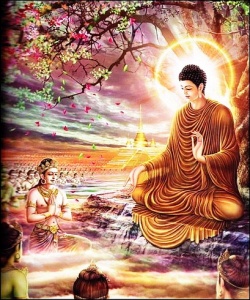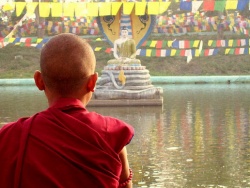Jodosanbukyo (the Three Pure Land Sutras)
==Honen's Interpretation of the Pure Land Sutras==
There are hardly any recorded comments by Honen on Pure Land thought in India. During his life, he did refer to several commentaries and sutras that were thought to have been written in India, but as there are no remarks on Sanskrit texts or terms in any of Honen's writings, we can assume that he did not learn the language while on Mt. Hiei. From this we can further conclude that he held the generally accepted designations of his time regarding which sutras and writings were of Indian origin. Thus it is only from Honen's references on these sutras and writings that we can come to understand Honen's views on Pure Land thought in India.
Honen is said to have read through the entire contents of the repository of sacred texts on Mt. Hiei. In the first chapter of the Senchakushu, Honen states that among all the sutras which were preserved there, only the Sutra of Immeasurable Life, the Meditation Sutra, and the Amida Sutra fully and rightfully expound the teaching of birth in the Pure Land through Amida Buddha's power. He listed the Avatamsaka Sutra (Kegon-kyo), the Lotus Sutra (Myoho-renge-kyo), the Sui-ch'iu-t'o-lo-ni ching (Kagawa)1 and the Tsun-sheng-t'o-lo-ni ching (Shogei)2 as texts which incidentally expound the teaching of birth in the Pure Land. Honen also mentioned various other sutras which expound ways of attaining birth in the Pure Land, but he confined his designation of the true teachings to only the Jodosanbukyo (the Three Pure Land Sutras).
This designation was the first time that these three sutras had been compiled into one definitive teaching on Pure Land Buddhism. According to his lecture compiled as the Amidakyoshaku, Honen listed six texts as key in making this designation. They are the Commentary on the Meditation Sutra (Kuan wu-liang-shou ching shu) by Shan-tao, the Ching-t'u-shi-i lun attributed to T'ien T'ai Master Chih-i, the Shi-fang-yao-chueh attributed to Tz'u-en, the Ching-t'u lun by Chia-ts'ai, a commentary by Chih-ching (non-extant) and the Ojoyoshu by Genshin. Although these authors regarded the three sutras as very important, they did not confine essential Pure Land thought to them.
Honen ordered the Jodosanbukyo chronologically as the the Sutra of Immeasurable Life, the Meditation Sutra, and the Amida Sutra). He felt this ordering was a logical one based on seven points in the Sutra of Immeasurable Life and three of his own insights (SHZ. 342 & 268-269).3 Firstly, he felt the Sutra of Immeasurable Life explains the practices Dharmakara Bodhisattva undertook in becoming Amida Buddha, while the Meditation Sutra describes more the way Amida Buddha then leads people from this life to the Pure Land through the nembutsu. Secondly, he felt the Sutra of Immeasurable Life details the method of reciting the nembutsu (one of the seven points) while the Meditation Sutra merely touches on this theme of recitation. Finally, he felt the Sutra of Immeasurable Life describes in detail Dharmakara Bodhisattva's creation of his forty-eight vows and his subsequent establishment of the Pure Land. On the other hand, the Meditation Sutra talks of these actions but does not go into detail. From these three points, Honen felt the Sutra of Immeasurable Life preceded the Meditation Sutra because of its fully detailed and original explanation of Pure Land teachings of which the Meditation Sutra seems to make explanations and commentaries.
Regarding the ordering of the Meditation Sutra and the Amida Sutra, Honen notes that the Meditation Sutra discusses a variety of nembutsu practices other than recitation. Honen regarded this as difficult and confusing for the ordinary person. He notes that, in the Amida Sutra, only the recited nembutsu is put forward, thus making attainment of birth in the Pure Land clearer and simpler. In this way, Honen saw that the Amida Sutra succeeded the Meditation Sutra in its ultimate selection of the recited nembutsu over the other various forms of nembutsu practice put forth in the Meditation Sutra.4 It is important to note, however, that contemporary scholarship has refuted Honen's ordering, stating that the Sutra of Immeasurable Life is the oldest of the sutras followed by the Amida Sutra. while the Meditation Sutra is generally placed as the most recent of the sutras by most contemporary scholars (Fujita, 122-132, 206-221).
The Jodosanbukyo is Honen's original contribution to Pure Land thought which he did partially out of the already widely held reverence for other such collections made by Japanese sects at the time, such as Tendai's [[Three Sutras of the Lotus[teaching]] (Hokke no sanbukyo), Shingon's Three Sutras on Mahavairocana (Dainichi no sanbukyo), Tendai's Three Sutras of Safeguarding the Nation (Chingokokka no sanbukyo), and Hosso's Three Sutras on Maitreya (Miroku no sanbukyo).
Notes:
1. This sutra corresponds to the P'u-pien-kuang-ming ching-ching-ch'ih-sheng ju-i-pao-yin-hsin wu-neng-sheng ta-ming-wang ta-sui-ch'iu-t'o-lo-ni ching translated into Chinese by Amoghavajra (T. 1153).
2. This sutra indicates the Fo-ting tsung-shen-t'o-lo-ni ching translated by Buddhapala (T. 967).
3. Rozanji manuscript of the Senchakushu & Gyakushu seppo.
4. Kohon Kango Toroku (A manuscript of the Kango Toroku found in Zensho-ji), Fascicle III, 2.
References:
Fujita Kotatsu, Genshi Jodo Shiso no kenkyu (Tokyo: Iwanami shoten, 1970).
Kagawa Koyu, Honen shonin no kyoten kan, Honen shonin kenkyu.
Shogei, Ketsgisho jikitetsu, JZ. 7:486.

